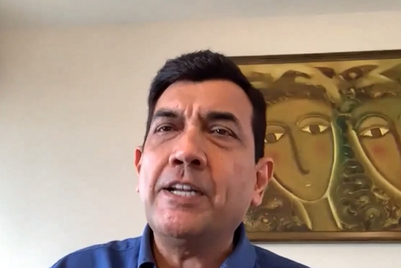.jpg&h=570&w=855&q=100&v=20250320&c=1)
At an intimate gathering at Soho House Mumbai earlier this month, Ember — claims to be India’s first 100% non-toxic non-stick cookware brand — announced a new chapter with celebrated chef and entrepreneur Saransh Goila joining as an investor and partner. For Ember, the partnership blends culinary insight with product innovation, while for Goila it signals more than just another chef-brand tie-up.
TechSci Research valued India's non-stick cookware market at $744.27 million in 2024 and anticipates it to grow $1,085.7 million by 2030 with a CAGR of 6.50% during forecast period. Most brands in this sector often lean on celebrity chefs as endorsers. Sanjeev Kapoor, Ranveer Brar, and Vikas Khanna have all fronted ranges that carry their names but not their equity.
Goila’s association with Ember is different. He is not just licensing his name but investing in the company and committing time to shape its direction.
“With equity, you’re not just endorsing; you’re building. This gives me a seat at the table for decisions that shape Ember’s trajectory for years to come,” Goila told Campaign India in an exclusive interaction.
That seat comes with responsibility. Goila will spearhead Ember’s new innovation lab, developing and testing solutions for the modern Indian kitchen.
The MasterChef Australia judge will lean into this personal connection to clean cookware, which runs deep. “Managing my mother’s health through an autoimmune condition showed me how deeply the tools we use in our kitchens affect our well-being,” he said. “India’s kitchens deserve better, but the gap is clear. The only real way to solve it is to design the kitchen of the future.”
Positioning against incumbents
By tying itself to Goila’s credibility, Ember is deliberately rejecting the mass licensing strategy. Its positioning is built on storytelling, design, and wellness rather than simply pushing more pans into retail channels. In a market where most cookware players emphasise durability or affordability, Ember wants to turn cookware into a lifestyle choice.
“People who cook at home are not just looking for utensils,” Goila said. “They are looking for tools that make the mundane act of cooking elevated.”
That pitch matters in a segment where cookware, unlike fast-moving consumer goods, has long replacement cycles. Repeat sales are limited, making constant innovation and relevance critical.
Ember’s bet is that Goila’s standing among younger, health-conscious home cooks will help it carve out space against entrenched players. The company is backed by Palette Brands, which raised $2 million last year. A substantial portion of that funding has been earmarked for marketing and distribution, signalling an ambition to compete beyond digital storefronts. Goila has also personally invested in the brand, extending his stake beyond reputation to capital.
The company is weighing expansion not just in India but also in select overseas markets where Indian-origin cookware resonates. Manufacturing is expected to remain India-focused in the near term, with distribution networks scaling online-first before moving into curated offline retail.
Goila’s role extends into how Ember will scale responsibly. “It’s not about being on every kitchen shelf; it’s about being in the right kitchens, in multiple forms,” he said. That means SKU expansion, modular accessories, and entry-level products designed to draw in new customers without diluting the premium identity.
Marketing on a startup budget
The cookware business is advertising-heavy. Incumbents rely on television commercials, print, and outdoor hoardings, all expensive channels. For a startup, replicating that playbook is not viable. Ember’s approach is different.
“Old-school cookware players over-rely on OOH, print, and TV high-ticket mediums that might not provide maximum ROI for an attacker brand,” Goila said. Instead, Ember is betting on digital-first marketing, influencer-driven content, and video commerce. The goal is to reach aspirational consumers in spaces they already occupy online, not in expensive mass media.
“It’s about crafting touchpoints that ignite both aspiration and approachability, while getting maximum mileage out of every rupee of the marketing spend,” he explained.
A dedicated agency will handle scale, but much of Ember’s brand voice and creative direction will remain in-house. The intent is to maintain authenticity while still reaching wide audiences.
For Goila, digital-first comes naturally. He was among the early adopters of influencer-driven food content and continues to see creators as pivotal in driving brand salience.
“Creators make cooking aspirational, relatable, and viral simultaneously. Collaborations will be the centre of Ember’s journey,” he said.
The brand plans to harness Goila’s own digital presence and wider food creator networks to build cultural relevance. Influencer-led campaigns, shoppable video formats, and live cooking experiences are expected to replace the traditional advertising bursts that cookware brands have historically relied upon.
This community-first strategy also fits with Ember’s target audience — city-based millennials and Gen Z home cooks. For them, cookware is not just functional but also aesthetic, something that signals lifestyle choices. Ember hopes to make cookware part of that expression.
Building kitchens, not just products
That philosophy is informed by Goila’s past experience. His earlier cookware experiment, Delishaas, gave him first-hand lessons in the gap between marketing promises and product functionality.
“It taught me that cookware isn’t so much about how great it photographs in a catalog — it’s about how great it cooks in someone’s home, night after night,” he said.
That lesson has carried over to Ember, where utility and performance are prioritised over optics. Its brand narrative is designed to extend beyond cookware into the broader idea of healthier kitchens. For Goila, the link between wellness and design is central.
“Ember combines clean living, great design and scalable innovation, and together we’re building kitchens that are smarter, cleaner and better,” he said.
The ambition is to place Ember not just in retail aisles but in cultural conversations around health, food, and sustainability. The Soho House launch, with its mix of live cooking and design-led displays, was emblematic of that positioning.
As Ember enters a market dominated by established names, it carries the hallmarks of Goila’s entrepreneurial instinct: the strategic risk of equity, the discipline of digital-first marketing, and the belief that cookware can move from commodity to lifestyle.
For now, the focus is on scaling India operations, building consumer trust, and ensuring that the product experience matches the marketing promise. Beyond that lies the possibility of international expansion and a wider product ecosystem.
The challenge will be balancing aspiration with affordability, and innovation with consistency. In a category shaped by legacy names and traditional advertising muscle, Ember is betting on a celebrity chef’s credibility, a startup’s agility, and a consumer base ready to pay for cleaner, smarter kitchens.


.jpg&h=334&w=500&q=100&v=20250320&c=1)
.jpg&h=334&w=500&q=100&v=20250320&c=1)

.jpg&h=334&w=500&q=100&v=20250320&c=1)
.jpg&h=334&w=500&q=100&v=20250320&c=1)
.jpg&h=334&w=500&q=100&v=20250320&c=1)
.jpg&h=334&w=500&q=100&v=20250320&c=1)

.jpg&h=334&w=500&q=100&v=20250320&c=1)



.jpg&h=268&w=401&q=100&v=20250320&c=1)

.jpg&h=268&w=401&q=100&v=20250320&c=1)
.jpg&h=268&w=401&q=100&v=20250320&c=1)
.jpg&h=268&w=401&q=100&v=20250320&c=1)
.jpg&h=268&w=401&q=100&v=20250320&c=1)
